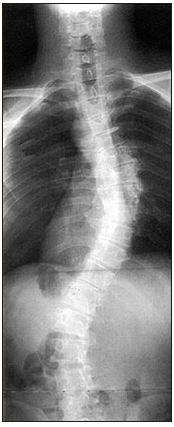There are a variety of reasons why scoliosis may develop in adults. Curvature in the mature spine may be:
- Secondary – Developed in response to other spinal conditions that affect spinal alignment and balance, such as osteoporosis or degenerative disc disease. Scoliosis that develops as a result of spinal degeneration typically is called degenerative adult scoliosis.
- Idiopathic – Resulting from no specific cause.
- Congenital – Caused by a condition present at birth but previously undetected
- Paralytic – The result of paralysis caused by a spinal cord injury. When the muscles surrounding the spine no longer work, the vertebrae of the spine may become unbalanced.
- Myopathic – Similar to paralytic curvature, in that the muscles no longer work properly, but as a result of a muscular or neuromuscular disease, such as muscular dystrophy or cerebral palsy.
Diagnosis
Should you notice any one or more of the above potential indicators of scoliosis, please make an appointment with your doctor for a thorough spinal and physical examination.
Diagnosis testing
- x-rays,
- computed tomography (CT)
- magnetic resonance imaging (MRI).
To determine the extent to which a curve has progressed, it’s measured using the Cobb Method and categorized in terms of degrees. Generally speaking, a curve is considered significant if it is greater than 25 to 30 degrees. Curves exceeding 45 to 50 degrees are considered severe and often require more aggressive treatment.
Treatment
Surgery is usually only recommend when non-surgical treatment, such as medication, exercise, physical therapy and/or bracing has failed to adequately relieve symptoms. The difficulty of surgically treating adult scoliosis increases with age. With advancing age, degenerative changes may lead to stiffening of the spine, making it less amenable to realignment and correction. In addition if osteoporosis is present it may be difficult for your neurosurgeon to successfully attach the instrumentation required for the surgical procedure to the vertebral bodies.
Your neurosurgeon may consider surgical correction if:
- You’re experiencing chronic, debilitating pain that has failed to respond to conservative treatment;
- If your curve has contributed to the development of spinal stenosis (narrowing of the spinal canal that causes pressure on the spinal cord);
- Your spinal curve continues to get worse, and has progressed to more than 40-45 degrees. (For curves above 60 degrees, the twisting of the torso can lead to more serious lung and heart conditions.); and
- If physical deformity has become unbearable to you for other physical or aesthetic reasons.
- If you have progressive, neurological changes such as numbness, tingling or weakness, or decreased tolerance for walking. (This may indicate neurocompressive disease in addition to spinal curvature.)
Surgical goals for those who have already reached skeletal maturity, the considerations and goals of treatment are somewhat different than those whose bones are not yet fully formed.
- Reducing the curve (straightening the spine as much as possible);
- Stopping the progression of the curve;
- Removing pressure from the nerves and spinal cord; and
- Protecting the nerves and spinal cord from further damage.
- In older patients, allowing nerve decompression to improve neurological function of the lower extremities.
Toward this end, your spine surgeon may recommend spinal fusion, the goal of which is to correct the spinal deformity as much as possible and fuse, or join together, the vertebrae in the curve to be corrected. The procedure involves approaching the spine either from the front (anterior approach), the back (posterior approach) or both. Your procedure may be minimally invasive, and/or also involve a discectomy(removal of disc material, a procedure that may be included in an anterior approach) to relieve pressure on the spinal cord.
The decision to treat adult scoliosis surgically requires careful consideration between you and your doctor. Factors to be considered include your specific condition and overall physical health. Discuss your condition thoroughly with your doctor, and rely on his or her judgment regarding which treatment option is most appropriate.


